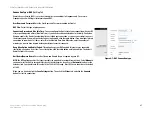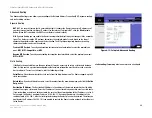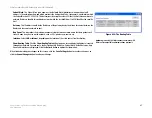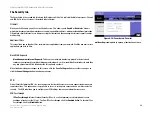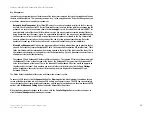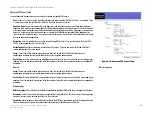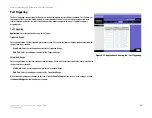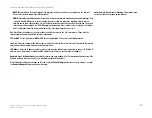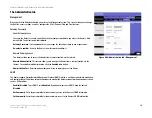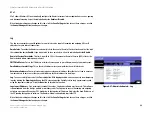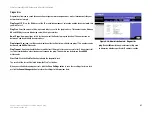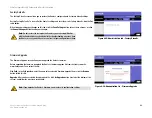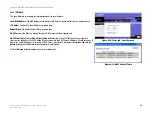
29
Chapter 6: Using The Router’s Web-based Utility
The Security tab
EtherFast Cable/DSL VPN Router with 4-Port 10/100 Switch
PPTP Pass Through
. Point-to-Point Tunneling Protocol Passthrough is the method used to enable VPN
sessions to a Windows 2000 server. To allow PPTP Passthrough, click the
Enabled
button. To disable PPTP
Passthrough, click the
Disabled
button.
When finished making your changes on this screen, click the
Save Settings
button to save these changes, or
click the
Cancel
Changes
button to undo your changes.
VPN Tunnel
Establishing a Tunnel
The Router creates a tunnel or channel between two endpoints, so that the data or information between
these endpoints is secure. To establish this tunnel, select the tunnel you wish to create in the Select Tunnel
Entry drop-down box. It is possible to create up to 50 simultaneous tunnels. To delete a tunnel, click the
Delete
button. To view a summary of that tunnel, click the
Summary
button.
Then check the box next to
Enable
to enable the tunnel.
Once the tunnel is enabled, enter the name of the tunnel in the
Tunnel Name
field. This is to allow you to
identify multiple tunnels and does not have to match the name used at the other end of the tunnel.
Local Secure Group and Remote Secure Group
A Local Secure Group is a computer(s) on your network that can access the tunnel. A Remote Secure Group is a
computer (s) on the remote end of the tunnel that can access the tunnel. Under Local Secure Group and Remote
Secure Group, you may choose one of three options: Subnet, IP Address, and IP Range. Under Remote Secure
Group, you have two additional options: Host and Any.
Subnet
. If you select Subnet (which is also the default), this will allow all computers on the local subnet to
access the tunnel. When using the Subnet setting, the default values of 0 should remain in the last fields of
the IP and Mask settings.
IP Address
. If you select IP Address, only the computer with the specific IP Address that you enter will be
able to access the tunnel.
IP Range
. If you select IP Range, it will be a combination of Subnet and IP Address. You can specify a range
of IP Addresses within the Subnet which will have access to the tunnel.
The next to options are for Remote Secure Groups only.
Host
. If you select Host for the Remote Secure Group, then the Remote Secure Group will be the same as the
Remote Security Gateway setting: IP Address, FQDN (Fully Qualified Domain Name), or Any.
Figure 6-17: Local and Remote Secure Group
Figure 6-16: Security tab - VPN







